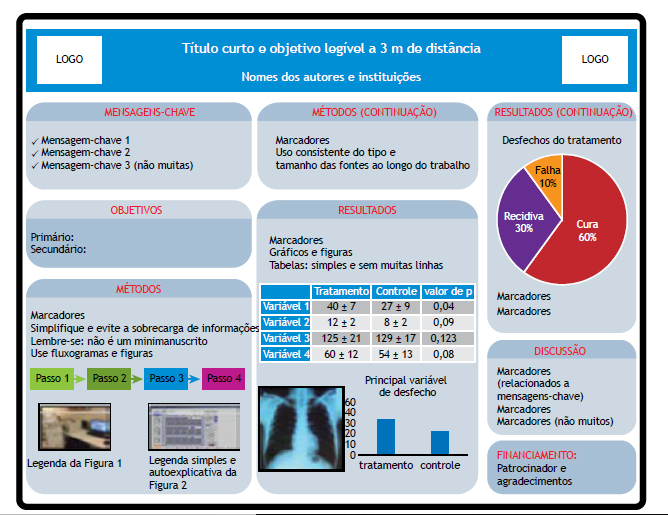O objetivo geral de apresentar um pôster em uma conferência é comunicar e receber feedback de colegas sobre os resultados de sua pesquisa, bem como aumentar sua network científica. Para aproveitar ao máximo essa oportunidade, em um ambiente no qual os participantes da conferência ficam sobrecarregados com novas informações, os apresentadores de um pôster precisam comunicar seus resultados de forma eficaz.
UM PÔSTER NÃO É UM MINIMANUSCRITOO erro mais comum cometido pelos pesquisadores ao elaborar e apresentar um pôster é tratá-lo como se fosse um minimanuscrito. Lembre-se, o objetivo é comunicar de forma clara e rápida o conteúdo científico para participantes que estão caminhando por uma grande área com muitos pôsteres, com tempo e atenção limitados para ler informações extensas.
Comunicar o estudo com sucesso dependerá de atrair os participantes para o pôster e tornar fácil para eles captar as mensagens-chave. Considere a regra prática 10-10 para visualização de pôsteres: os participantes olham para os pôsteres por 10 segundos e a uma distância de 10 pés (3 metros).(1,2) Durante esses 10 segundos, se forem atraídos pelo pôster, poderão querer ler mais informações. Portanto, as mensagens-chave devem ser escritas com um tamanho de fonte grande o suficiente para as pessoas lerem a 3 metros de distância, e as informações devem ser interessantes e atraentes o suficiente para que os participantes queiram se aproximar, ler mais e fazer perguntas.
COMO PREPARAR SEU PÔSTERO conselho mais importante é evitar a sobrecarga de informações. Lembre-se: não é um minimanuscrito e os participantes têm tempo limitado. Recomendamos que você use marcadores, minimize o texto e simplifique a linguagem, com frases fáceis de ler. Use a voz ativa e evite jargões e acrônimos sempre que possível. O título deve ser curto e informativo. O canto superior esquerdo é a primeira área para a qual os participantes irão olhar após lerem o título naqueles 10 segundos, então evite escrever uma introdução (lembre-se, não é um manuscrito); em vez disso, comece com as mensagens-chave (Figura 1). Em seguida, exponha os objetivos ou pergunta do estudo para que os leitores saibam do que trata o estudo. Ao descrever os métodos, evite detalhes desnecessários e use fluxogramas ou figuras para ilustrar o processo metodológico. Os resultados são as informações mais importantes que você irá comunicar. Use figuras e gráficos com fonte legível, eixo claro e com a legenda incorporada ao gráfico/figura. Termine o pôster com uma discussão que se alinhe à pergunta do estudo.
 Figura 1.
Figura 1. Modelo de pôster com exemplos de cabeçalhos,figuras, gráficos, cores e tamanho de fonte grande.
Verifique as diretrizes da conferência para orientação e tamanho do pôster. Use colunas e cabeçalhos para facilitar a leitura. Resista à tentação de preencher todo o espaço disponível, deixe algum espaço em branco para tornar o pôster mais atraente. É importante ser consistente na redação, no uso e tamanho das fontes e no uso de cores.
MENSAGENS-CHAVE
- Um pôster não é um minimanuscrito; evite comunicar muitas informações
- Tenha cuidado ao usar um tamanho de fonte pequeno que seja difícil de ler a uma distância confortável
- Substitua texto por figuras e gráficos sempre que possível
- Treine apresentar o pôster para seus amigos e colegas pelo menos cinco vezes
- Esteja preparado, pareça e aja de forma profissional e faça valer o esforço
-
- REFERÊNCIAS
1. Hamilton CW. At a glance: a stepwise approach to successful poster presentations. Chest. 2008;134(2):457-459. https://doi.org/10.1378/chest.08-1078
2. Persky AM. Scientific Posters: A Plea from a Conference Attendee. Am J Pharm Educ. 2016;80(10):162. https://doi.org/10.5688/ajpe80455


